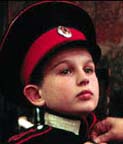|
THE VIEWFINDER Introduction by Dirck Halstead |
|
|
During the Palm Beach Photo Workshop earlier this year, I was privileged to view an exhibit of portraits of Russians by photographer Robert Wallis. What struck me at the time was how vivid the characters were. The subjects were iconic. There was no doubt about their who they were, where they lived, or what they did. Each face conveyed a story, each the result of living in a society undergoing tremendous changes and pressures. In the months since, I had an opportunity to review the work of National Geographic photographer Gerd Ludwig, who has spent substantial amounts of time photographing Russia in the past few years. The visual strength of his images added to my feeling that it was time to explore Russia as a photographic study in the page of The Digital Journalist. Most of the photojournalism shot during the Communist era of the Soviet Union was not permitted to be seen abroad. It came as a great surprise therefore, in the mid '80s, when LIFE published a portfolio of photographs taken by Russian combat cameramen during World War II. It was as though a new window had been opened to view this historic period.
This feature started with the essays of Wallis and Ludwig. Neither man is Russian. Washington Post staff photographer Lucian Perkins, who has been one of the organizers of Interphoto, an international photo festival in Moscow held for the past years, has written an essay looking at an overview of Russian photojournalism today. Most importantly, during the coming festival which will be held later this month, Lucian will be working with Russian photojournalists, and inviting them to submit their work for a special gallery that will be opened on the pages of The Digital Journalist. We hope that they will contribute, and share their work and experiences with us all. |
|
 About
that time, I was in Moscow as one of a team of international photographers
producing the book "A Day In The Life of the Soviet Union." At a reception
I was introduced to the dean of Soviet photojournalism, Dimitri Baltermans.
I couldn't wait to tell him how much I admired a photograph he taken during
World War II, depicting the carnage at the gates of Moscow during the German
siege. He told me that as a TAAS photographer, every morning he would drive
to the front lines from Moscow, a distance of less than 10 miles, to photograph
the aftermath of the battles fought the night before. One of his images
of a mother grieving over her dead son was one of the most gripping of
the war. I asked him if it would possible to get a signed print, and he
told me would be happy to make me one. However, in the days I had left
in Moscow, I never saw again. Several years later I was back, this time
as part of the White House press corps with Ronald Reagan, and on snowy
night there was a knock on my hotel door. When I opened it, I was shocked
to see Baltermans, pale and shivering. He handed me a package. It contained
the print, which he had signed. Somehow, although sick, he had managed
to find me. Two weeks later he died. The print is now one of my prized
possessions.
About
that time, I was in Moscow as one of a team of international photographers
producing the book "A Day In The Life of the Soviet Union." At a reception
I was introduced to the dean of Soviet photojournalism, Dimitri Baltermans.
I couldn't wait to tell him how much I admired a photograph he taken during
World War II, depicting the carnage at the gates of Moscow during the German
siege. He told me that as a TAAS photographer, every morning he would drive
to the front lines from Moscow, a distance of less than 10 miles, to photograph
the aftermath of the battles fought the night before. One of his images
of a mother grieving over her dead son was one of the most gripping of
the war. I asked him if it would possible to get a signed print, and he
told me would be happy to make me one. However, in the days I had left
in Moscow, I never saw again. Several years later I was back, this time
as part of the White House press corps with Ronald Reagan, and on snowy
night there was a knock on my hotel door. When I opened it, I was shocked
to see Baltermans, pale and shivering. He handed me a package. It contained
the print, which he had signed. Somehow, although sick, he had managed
to find me. Two weeks later he died. The print is now one of my prized
possessions.




